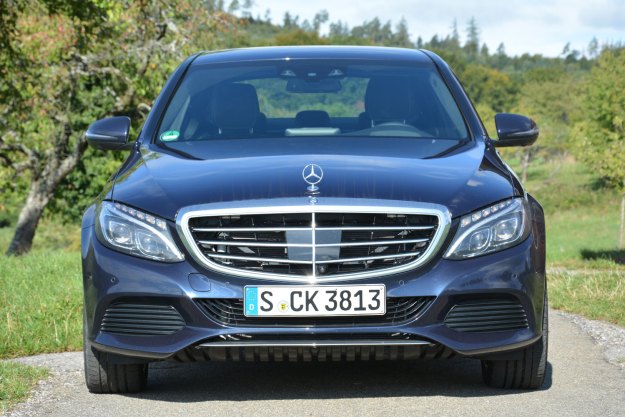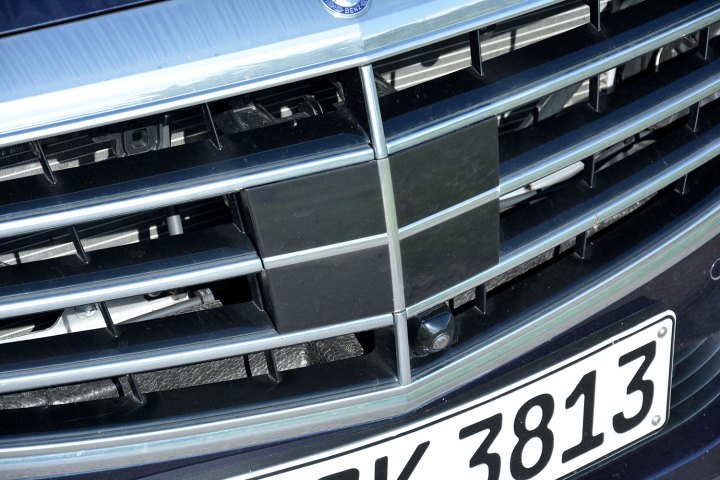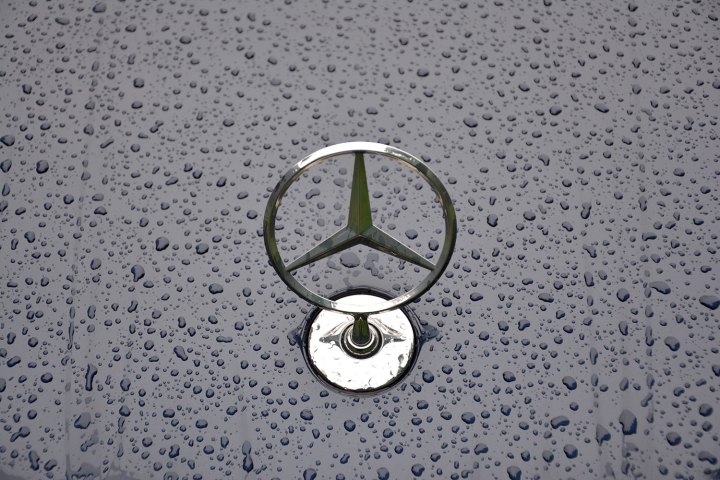
“The C250d is a comfortable, powerful and efficient cruiser that excels on the highway, regardless of whether or not traffic is moving.”
- Supremely comfortable on long drives
- Fast, efficient four-cylinder turbodiesel
- Can drive itself in traffic jams
- Best-in-class cabin
- Straightforward heads-up display
- COMAND takes some getting used to
- Options bump the C250d into E-Class territory
It’s admittedly not the best time to review a diesel-powered car. Oil-burners have been lambasted by the media, by government officials, and by consumers in the wake of the on-going scandal that erupted when Volkswagen admitted it built 11 million cars fitted with an illegal defeat device designed to cheat on emissions tests.
It’s important to remember that not all diesels are fitted with this device. In the United States, only cars manufactured by Volkswagen and Audi are affected. Turbodiesel engines built by Mercedes-Benz (and rival BMW) are fully compliant with emissions regulations both on our shores and across the Atlantic.
In short, it’s possible to build a clean diesel engine without sacrificing performance. Motorsport enthusiasts will remember that a mostly stock Mercedes-Benz C250d recently completed the 12.4-mile long Pikes Peak Hill Climb in 11 minutes and 22 seconds, an all-time record for a car equipped with a turbodiesel engine.
Although you can’t go down to your local dealer and buy a C250d, you’ll soon be able to order a new variant of the C-Class called C300d 4Matic that Mercedes tells me will be all but identical to it. Intrigued, I flew to Germany to get a better idea of what to expect when Mercedes’ North American arm launches its first diesel compact sedan since the 190D (w201).
The basics
The C250d is equipped with a 2.1-liter turbodiesel four-cylinder engine, a time-proven unit that has powered a long list of Mercedes models including the E, the outgoing GLK, the new GLE and even the Sprinter van. In this application, it sends 201 horsepower and a generous 369 pound-feet of torque to the rear wheels via a seven-speed dual-clutch transmission that can either be left in drive or shifted manually using paddles. Mercedes’ 4Matic all-wheel drive system is available at an extra cost.
If you’ve ever driven an older diesel you likely remember having to wait for the orange glow plug light to turn off before you can start the engine. It’s sometimes called “a moment of silence for Rudolf Diesel,” the mechanical engineer who is credited for inventing the diesel engine over a hundred years ago. The wait is a thing of the past, and it’s possible to start the C250d instantly in virtually all weather conditions. It comes to life with the deep, low rumble that’s expected from a compression-ignition engine, but the noise isn’t overly loud and it becomes markedly less audible as the four-cylinder warns up.
Born on the Autobahn
The C is surprisingly maneuverable at low speeds thanks to a nicely-weighted steering rack. Navigating Germany’s network of tight parking garages and narrow, cobblestone-paved streets isn’t as nerve-racking as it might initially sound. Parking sensors (and an available 360-degree camera) help make up for the fact that the latest C’s more rounded design makes it harder to tell where the front bumper ends and where the concrete wall begins.
You can’t buy a C250d in the U.S., but you’ll soon be able to order a new variant of the C-Class called C300d that will be all but identical to it.
Mercedes dialed five driving modes called Sport, Sport +, Eco, Comfort and Individual, respectively, into the C-Class. There’s a noticeable difference between all of the modes in terms of performance, efficiency, and the firmness of the suspension. Ticking Sport + and using the shift paddles makes the C250d more engaging to drive on twisty mountain roads, but comfort mode is best suited to the sedan’s tranquil yet powerful character. Handling remains precise, and the automatic transmission goes through the gears so smoothly that the shifts are nearly imperceptible.
The C250d is a car that was designed for – and honed on – Germany’s Autobahn. No speed limits; it’s one thing to read about it, it’s another thing entirely to see a sign that says your destination is, say, 175 kilometers away and to think “I can be there in an hour.”
With older diesels, it was almost necessary to make an appointment before merging on the freeway. With the C250d, getting up to freeway speeds is a breeze because the V6-like torque produced by the turbo four sends it from zero to 62 mph in just 6.4 seconds. In other words, the C250d can keep up with a Volkswagen GTI down a drag strip.

The sedan is perfectly calm and composed while the engine is quietly screaming away under the hood. Even with the pedal mashed to the floor, the 250 never sounds buzzy or feels like it’s running out of breath. It eats up freeway miles the way only a Mercedes can. The brakes are powerful enough to bring it down to a stop from triple-digit speeds with no fuss, and the suspension soaks up bumps and potholes before they can reach the passengers’ spines.
I averaged about 50 mpg while driving through villages, in urban centers, on back roads and on the freeway at high speeds. That’s about on par with what Mercedes says you can expect from the C in mixed driving.
As autonomous as it gets
You can’t drive at a constant 100 mph on the Autobahn because some sections of it – notably those close to major cities – are limited to 120 km/h (roughly 75 mph). Besides, motorists encounter traffic jams, road work, trucks and careless drivers. Rest assured, the C was designed to tackle all of these obstacles.
Adaptive cruise control (called Distronic Plus in Mercedes-speak) is designed to take the unpredictability out of freeway driving. Like a regular cruise control, it keeps the car moving at a steady speed without any input from the driver. However, an array of cameras and sensors allows Distronic Plus to autonomously slow the C down if it senses that, for example, a slower car pulls out ahead to pass a truck. Once the car returns to its lane, Distronic Plus immediately re-accelerates back to the previously-set speed. What’s impressive is that the system is programmed to brake and accelerate like a human driver.
The generous amount of torque produced by the 2.1-liter turbo four sends the C250d from zero to 62 mph in just 6.4 seconds.
Distronic Plus can also bring the car to a full stop if it detects a traffic jam, and it can automatically follow the car in front. The driver simply needs to occasionally blip the throttle to tell the system that it’s time to move again after particularly lengthy stops.
My tester was equipped with a forward-thinking feature called steering assist that works in unison with Distronic Plus. When turned on, steering assist reads the road markings and keeps the car in its lane by autonomously turning the wheel. This technology is life changing for commuters who regularly find themselves stuck in traffic. Distronic Plus and steering assist are about as close to a self-driving car as you can legally buy and drive on public roads today.
There are limitations to the system. Steering assist senses when the driver’s hands are off the wheel for too long, and it emits audible warnings as well as messages that show up on the TFT screen in the instrument cluster. Additionally, Distronic Plus won’t brake for speed cameras if it’s set slightly higher than the posted limit. Believe me, I tried – sorry, Mercedes.
In the lap of luxury
As quiet as a bank vault, the C boasts the best interior in its class, hands down. All of the materials used are top notch, the build quality is worthy of a car a class up, and the slanted center console creates an elegant, upscale ambiance that was missing in the last-gen C. The trade-off is that the only cup holders are located at the bottom of the door panels, and sticking bigger drinks in them is not very practical. Forget about the Big Gulp. Additionally, knee padding on the center console would do wonders on longer drives.
The sheer amount of tech packed into the C means that there will inevitably be a learning curve for drivers coming from a car that’s not a late-model Mercedes. Notably, it’ll take a few tries before drivers new to the three-pointed star brand will feel fully comfortable navigating the COMAND infotainment system using the controller knob on the center console. That being said, the handwriting recognition software is surprisingly accurate and user-friendly.
The heads-up display is one of the best units I’ve tested on any car. It’ll quickly become a motorists’ best friend because it very clearly provides the speed, the posted speed limit and the navigation directions without any distractions to speak of. Mark my words; one day straightforward heads-up displays like the one in the C2250d will replace the instrument cluster as we know it.
Not all diesels are created equal
The DT Accessory Pack
Up your game with these accessories, hand picked by DT editors:
Mercedes-Benz Exterior Car Care Kit ($47)
Keep your C as clean as it was on the day you took it home.
Mercedes C-Class W20 Model Car ($150)
The best way to display your new Mercedes on your desk.
Daimler & Benz: The Complete History ($28)
Learn more about your C-Class’ ancestors.
Mercedes Benz Men’s Black Soft Shell Jacket ($110)
Because you can’t take your heated seats hiking with you.
The reputation of diesel-powered cars is damaged, but the oil-burning engine isn’t dead yet thanks in part to well-engineered cars like the C250d.
Mercedes-Benz has a long history of building great diesel engines. The world’s first regular-production diesel-powered passenger car was the 1936 260 D, the 1978 300 SD (w116) was the first production turbodiesel car, and the 300D (w124) was the fastest oil-burner on the planet when it was introduced in 1986. Infused with these genes, the C250d is a comfortable, powerful and efficient cruiser that excels on the highway, regardless of whether or not traffic is moving.
Highs
- Supremely comfortable on long drives
- Fast, efficient four-cylinder turbodiesel
- Can drive itself in traffic jams
- Best-in-class cabin
- Straightforward heads-up display
Lows
- COMAND takes some getting used to
- Options bump the C250d into E-Class territory












